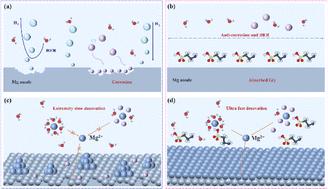Achieving high power density and stability in aqueous Mg–air batteries using taurine electrolyte additives
IF 5.3
2区 材料科学
Q2 MATERIALS SCIENCE, MULTIDISCIPLINARY
引用次数: 0
Abstract
Aqueous Mg–air batteries are promising candidates for large-scale energy storage, but their practical application is significantly hindered by water-induced parasitic reactions and the chunk effect. In this study, taurine (Tau) is an effective electrolyte additive for aqueous Mg–air batteries utilizing various magnesium anodes. The non-sacrificial Tau molecules, possessing both donor and acceptor groups, disrupt the inherent hydrogen bond network of H2O and replace solvated H2O in the Mg2+ solvation sheath, forming dynamic adsorption on Mg and creating a hydrophobic electric double layer. Consequently, taurine inhibits H2O attack on Mg, promoting uniform Mg stripping. An appropriate amount of Tau not only enhances the discharge activity of the AZ31 anode but also suppresses its self-discharge phenomenon, achieving a surprising effect of simultaneously boosting voltage and anode utilization. Therefore, 0.2 M Tau was identified as the optimal electrolyte concentration and successfully incorporated in Mg–air batteries utilizing various routine Mg anodes (such as VW83, VW103, and LA103Z). The results demonstrate that Tau effectively enhances the discharge properties for Mg–air batteries employing various magnesium anodes.

使用牛磺酸电解质添加剂实现水性镁-空气电池的高功率密度和稳定性
水溶液镁-空气电池是有希望实现大规模储能的候选电池,但其实际应用受到水引起的寄生反应和大块效应的严重阻碍。在这项研究中,牛磺酸(Tau)是一种有效的电解质添加剂,可用于使用各种镁阳极的水溶液镁-空气电池。非人工合成的 Tau 分子同时具有供体基团和受体基团,能破坏 H2O 固有的氢键网络,取代 Mg2+ 溶解鞘中的溶解 H2O,在 Mg 上形成动态吸附,形成疏水电双层。因此,牛磺酸能抑制 H2O 对 Mg 的侵蚀,促进 Mg 的均匀剥离。适量的牛磺酸不仅能提高 AZ31 阳极的放电活性,还能抑制其自放电现象,达到同时提高电压和阳极利用率的惊人效果。因此,0.2 M Tau 被确定为最佳电解质浓度,并成功地应用于使用各种常规镁阳极(如 VW83、VW103 和 LA103Z)的镁-空气电池中。结果表明,Tau 能有效提高采用各种镁阳极的镁-空气电池的放电性能。
本文章由计算机程序翻译,如有差异,请以英文原文为准。
求助全文
约1分钟内获得全文
求助全文
来源期刊

ACS Applied Nano Materials
Multiple-
CiteScore
8.30
自引率
3.40%
发文量
1601
期刊介绍:
ACS Applied Nano Materials is an interdisciplinary journal publishing original research covering all aspects of engineering, chemistry, physics and biology relevant to applications of nanomaterials. The journal is devoted to reports of new and original experimental and theoretical research of an applied nature that integrate knowledge in the areas of materials, engineering, physics, bioscience, and chemistry into important applications of nanomaterials.
 求助内容:
求助内容: 应助结果提醒方式:
应助结果提醒方式:


